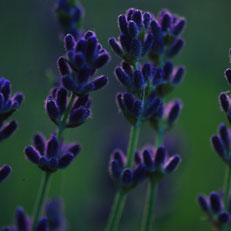
Photo © Steven Foster
Introduction
Lavender is an aromatic subshrub native to the low mountains (1,970-3,940 feet) of the Mediterranean basin. It is cultivated in France, Bulgaria, Italy, Spain, the former Yugoslavia, the Netherlands, the United Kingdom, the United States, and Australia.1,2 It should not be confused with the hybrid, lavandin or Lavandula xintermedia, which produces an oil with less desirable characteristics. Because lavenders have been cultivated for such a long time throughout history, garden lavenders are mostly hybrids and identification is often very difficult.2 History and Cultural Significance
Of all the essential oils, lavender is probably the most versatile, possessing an extremely diverse range of properties.3 Like many essential oils, lavender was used as an antiseptic in ancient Arabian, Greek, and Roman medicines. Its genus name comes from the Latin lavare, to wash, probably referring to its use as a bath additive for the purification of body and spirit. It was also used to clean hospitals and sick rooms in ancient Persia, Greece, and Rome. In the time of Pliny the Elder (23-79 BCE), the blossoms sold for 100 Roman denarii per pound. Knowledge of its healing abilities spread to India and Tibet. In the book Makhzan-El-Adwiya, it is called the broom of the brain, because it was believed to sweep away impurities. The Gyu-zhi, or Four Tantras, by Chandranandana is the earliest Indian medical text to be translated into Tibetan (8th Century BCE). In it, lavender is included as part of Tibetan Buddhist medicine.4 Lavender has been used traditionally for coughs and colds, and has been studied for analgesic, antiseptic, and antibiotic properties.3,5 When lavender oil is massaged into the body, it can help relieve pain. In aromatherapy, lavender is used for many varied skin conditions.6 Lavender has been used for many centuries as insect repellant for people and animals. The fresh flowers are added to jams, ice cream, vinegar, and herbal teas.5 The aromatic oil possesses a soothing odor used to scent many cosmetics, shampoos, and industrial products. Lavender oil is used as a flavor component in food products, including beverages (both alcoholic and non-alcoholic, aromatic vinegars, baked goods, candy, frozen dairy desserts, gelatins and puddings.7 The internal use of lavender is currently approved by the German Commission E for restlessness and nervous stomach.1 The German Standard License for lavender tea lists it for restlessness, sleeplessness, lack of appetite, and nervous stomach. Lavender preparations have been employed traditionally to treat symptoms of minor sleeplessness.1 Modern Research
Current research for external uses of lavender has shown some evidence for its ability to promote sleep.8 In addition, lavender aromatherapy reduced the level of perceived anxiety and physical symptoms of anxiety in nursing students.9 In hospice patients, it has elicited an increased sense of well-being.10 In other studies, lavender has been shown to reduce anger-frustration moods and negative responses about the future.11 Future Outlook
Although lavender has been cultivated for centuries, little is known about its sustainability as a long term crop. Lavender crops in the United Kingdom and France go 20 years without crop rotation. The Bridestowe Estate plantation in Australia is currently researching the sustainability of lavender and soil management with the long term cultivation of lavender.12 Aspects being studied include possible trace element depletion and using rotation and green manure organic matter to restore organic matter levels. As of 2002, lavender essential oil production was estimated at 200 tons per year, produced mainly in Europe.12 The reason for this relatively low number is that much of the “lavender” of commerce is actually lavandin, a lavender hybrid that is much easier to grow and which produces more essential oil on a per plant basis.12 References
1 Blumenthal M, Busse WR, Goldberg A, Gruenwald J, Hall T, Riggins CW, Rister RS, eds. Klein S, Rister RS, trans. The Complete German Commission E Monographs¾Therapeutic Guide to Herbal Medicines. Austin, TX: American Botanical Council; Boston: Integrative Medicine Communication; 1998. 2 Bown D. The Herb Society of America New Encyclopedia of Herbs and Their Uses. London: Dorling Kindersley Ltd.; 2001. 3 Schnaubelt, K. Medical Aromatherapy: Healing with Essential Oils. Frog, LTD: Berkeley, CA; 1999. 4 Blumenthal M, Goldberg A, Brinckmann J, eds. Herbal Medicine: Expanded Commission E Monographs. Austin, TX: American Botanical Council; Newton, MA: Integrative Medicine Communications; 2000. 5 Onstad D. Whole Foods Companion. Chelsea Green Publishing Co.: White River Junction, VT; 1996. 6 Lawless, J. The Illustrated Encyclopedia of Essential Oils: The Complete Guide to the Use of Oils in Aromatherapy and Herbalism. Dorset, UK: Element Books, Ltd; 1995. 7 Leung AY, Foster S, eds. Encyclopedia of Common Natural Ingredients Used in Food, Drugs, and Cosmetics. 2nd ed. New York: John Wiley and Sons, Inc; 1996 8 Basch E, Foppa I, Kingsbury E et al. Lavender: Natural Standard Monograph. Available at www.naturalstandard.com. Accessed March 20, 2004. 9 Park M, Lee S. The effect of aroma inhalation method on stress responses of nursing students. Taehan Kanho Hakhoe Chi. April 2004;34(2):344-51. 10 Louis M, Kowalski S. Use of aromatherapy with hospice patients to decrease pain, anxiety, and depression and to promote an increased sense of well-being. Am J Hosp Palliat Care. November-December 2002;19(6):381-6. 11 Morris N.The effects of lavender (Lavendula angustifolium) baths on psychological well-being: two exploratory randomised control trials. Complement Ther Med. December 2002;10(4):223-8. 12 Peterson L. The Australian Lavender Industry: A Review of Oil Production and Related Products. May 2002. Available at: www.rirdc.gov.au/reports/EOI/02-052.pdf. Accessed March 23, 2004.
|